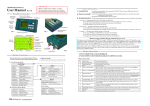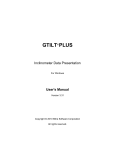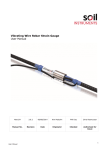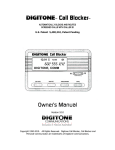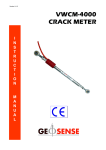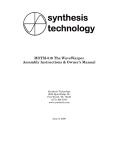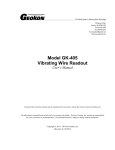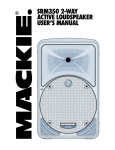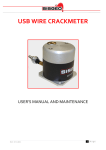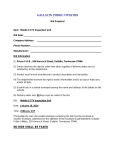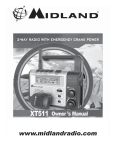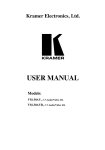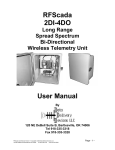Download 4420 Crackmeter
Transcript
Instruction Manual Model 4420 VW Crackmeter No part of this instruction manual may be reproduced, by any means, without the written consent of Geokon, Inc. The information contained herein is believed to be accurate and reliable. However, Geokon, Inc. assumes no responsibility for errors, omissions or misinterpretation. The information herein is subject to change without notification. Copyright © 1986, 1996, 2004, 2006, 2007, 2008, 2012, 2013 by Geokon, Inc. (Doc Rev Q, 6/13) Warranty Statement Geokon, Inc. warrants its products to be free of defects in materials and workmanship, under normal use and service for a period of 13 months from date of purchase. If the unit should malfunction, it must be returned to the factory for evaluation, freight prepaid. Upon examination by Geokon, if the unit is found to be defective, it will be repaired or replaced at no charge. However, the WARRANTY is VOID if the unit shows evidence of having been tampered with or shows evidence of being damaged as a result of excessive corrosion or current, heat, moisture or vibration, improper specification, misapplication, misuse or other operating conditions outside of Geokon's control. Components which wear or which are damaged by misuse are not warranted. This includes fuses and batteries. Geokon manufactures scientific instruments whose misuse is potentially dangerous. The instruments are intended to be installed and used only by qualified personnel. There are no warranties except as stated herein. There are no other warranties, expressed or implied, including but not limited to the implied warranties of merchantability and of fitness for a particular purpose. Geokon, Inc. is not responsible for any damages or losses caused to other equipment, whether direct, indirect, incidental, special or consequential which the purchaser may experience as a result of the installation or use of the product. The buyer's sole remedy for any breach of this agreement by Geokon, Inc. or any breach of any warranty by Geokon, Inc. shall not exceed the purchase price paid by the purchaser to Geokon, Inc. for the unit or units, or equipment directly affected by such breach. Under no circumstances will Geokon reimburse the claimant for loss incurred in removing and/or reinstalling equipment. Every precaution for accuracy has been taken in the preparation of manuals and/or software, however, Geokon, Inc. neither assumes responsibility for any omissions or errors that may appear nor assumes liability for any damages or losses that result from the use of the products in accordance with the information contained in the manual or software. TABLE of CONTENTS Page Instruction Manual ....................................................................................................................................... 1 MODEL 4420 .................................................................................................................................................. 1 VW CRACKMETER ........................................................................................................................................ 1 1. INTRODUCTION ........................................................................................................................................... 1 2. INSTALLATION ............................................................................................................................................ 2 2.1. PRELIMINARY TESTS................................................................................................................................... 2 2.2. CRACKMETER INSTALLATION ..................................................................................................................... 2 2.2.1. Installation using Weldable Fixtures ............................................................................................ 4 2.2.2. Installation using Groutable Anchors .......................................................................................... 4 2.2.3. Installation using Expansion Anchors ......................................................................................... 5 2.3 PROTECTION FROM MECHANICAL DAMAGE .................................................................................................. 6 THE STANDARD COVER PLATE IS LONG ENOUGH TO COVER THE TWO INCH RANGE CRACKMETER – LONGER RANGE CRACKMETERS MUST USE TWO OVERLAPPING COVER PLATES BOLTED TOGETHER. ................................. 6 2.4. CABLE INSTALLATION ................................................................................................................................ 6 2.5. ELECTRICAL NOISE ..................................................................................................................................... 6 2.6. LIGHTNING PROTECTION ...................................................................................................................... 7 3. TAKING READINGS ..................................................................................................................................... 8 3.1. OPERATION OF THE GK-403 READOUT BOX ............................................................................................... 8 3.2 OPERATION OF THE GK404 READOUT BOX ................................................................................................. 8 3.3 OPERATION OF THE GK-405 READOUT BOX ................................................................................................ 9 3.4. MEASURING TEMPERATURES...................................................................................................................... 9 4. DATA REDUCTION .................................................................................................................................... 10 4.1. DEFORMATION CALCULATION .................................................................................................................. 10 4.2. TEMPERATURE CORRECTION .................................................................................................................... 12 4.3. ENVIRONMENTAL FACTORS ...................................................................................................................... 13 5. TROUBLESHOOTING ................................................................................................................................ 13 APPENDIX A - SPECIFICATIONS ................................................................................................................ 15 A.1 MODEL 4420 CRACKMETER ...................................................................................................................... 15 A.2 THERMISTOR ............................................................................................................................................. 16 APPENDIX B - THERMISTOR TEMPERATURE DERIVATION ............................................................ 16 APPENDIX C – 3D ARRAYS ........................................................................................................................... 17 LIST of FIGURES, TABLES and EQUATIONS Page FIGURE 1: MODEL 4420-1-50/100/150/200/300 VIBRATING W IRE CRACKMETER............................................ 1 FIGURE 2 - MODEL 4420-1-12/25 DETAIL ........................................................................................................... 1 FIGURE 3 - ANCHOR TYPES WITH DIMENSIONS .................................................................................................... 2 TABLE 1 - CRACKMETER ANCHOR SPACING DISTANCES ..................................................................................... 3 TABLE 2 - CRACKMETER READING RANGES ......................................................................................................... 3 FIGURE 4 - INSTALLATION USING W ELDABLE FIXTURES ....................................................................................... 4 FIGURE 5 - INSTALLATION USING GROUTABLE ANCHORS .................................................................................... 4 FIGURE 6 - INSTALLATION USING EXPANSION ANCHORS ..................................................................................... 5 FIGURE 7 - TYPICAL COVER PLATE INSTALLATION ............................................................................................... 6 FIGURE 8 - LIGHTNING PROTECTION SCHEME...................................................................................................... 7 FIGURE 9 GK405 READOUT UNIT ......................................................................................................................... 9 EQUATION 1 - DIGITS CALCULATION ................................................................................................................... 10 EQUATION 2 - DEFORMATION CALCULATION ...................................................................................................... 10 TABLE 3 - ENGINEERING UNITS CONVERSION MULTIPLIERS ............................................................................. 10 FIGURE 10 - TYPICAL CRACKMETER CALIBRATION SHEET ................................................................................ 11 EQUATION 3 - THERMALLY CORRECTED DEFORMATION CALCULATION ............................................................ 12 EQUATION 4 - THERMAL COEFFICIENT CALCULATION ........................................................................................ 12 TABLE 4 - THERMAL COEFFICIENT CALCULATION CONSTANTS ......................................................................... 12 TABLE A-1 CRACKMETER SPECIFICATIONS ....................................................................................................... 15 EQUATION B-1 CONVERT THERMISTOR RESISTANCE TO TEMPERATURE ........................................................ 16 TABLE B-1 THERMISTOR RESISTANCE VERSUS TEMPERATURE ....................................................................... 16 FIGURE 11 TYPICAL 3D ARRAY............................................................................................................................ 17 FIGURE 12 3D ARRAY, CANTILEVER VERSION ................................................................................................... 18 1 1. INTRODUCTION Geokon Model 4420 Vibrating Wire Crackmeters are designed to measure movement across joints such as the construction joints in buildings, bridges, pipelines, dams, etc.; tension cracks in soils and joints in rock and concrete. The instrument consists of a vibrating wire sensing element in series with a heat treated, stress relieved spring which is connected to the wire at one end and a connecting rod at the other. The unit is fully sealed and operates at pressures of up to 250 psi. As the connecting rod is pulled out from the gage body, the spring is elongated causing an increase in tension which is sensed by the vibrating wire element. The tension in the wire is directly proportional to the extension, hence, the opening of the joint can be determined very accurately by measuring the strain change with the vibrating wire readout box. Figure 1: Model 4420-1-50/100/150/200/300 Vibrating Wire Crackmeter The Model's 4420-12 and 4420-25 differ slightly from the standard Crackmeter in that they provide for adjustment of the setting distance with a threaded extension rod and locking nut. Figure 2 - Model 4420-1-12/25 Detail CAUTION: Do not rotate the shaft of the Crackmeter more than 180 degrees: This may cause irreparable damage to the instrument. The alignment pin on the transducer shaft and slot on the body serve as a guide for alignment. Do not, under any circumstamces, extend the crackmeter beyond its working range 2 2. INSTALLATION 2.1. Preliminary Tests Upon receipt of the instrument, the gage should be checked for proper operation (including the thermistor). The Crackmeter normally arrives with it's shaft secured at approximately 50% of it's range, by either a split PVC sleeve, (for crackmeters over 100mm (4 inch) range), or a dowel pin held in place by a piece of tape, (see Figure 2). These devices hold the crackmeter in tension thereby helping to protect it during shipping. Remove this PVC split sleeve or dowel pin before proceeding. Connect the gage to the Readout to take a reading (see section 3). The reading should be stable and in the range of 4000 to 5000. Checks of electrical continuity can also be made using an ohmmeter. Resistance between the gage leads should be approximately 180 ohms, ±10 ohms. Remember to add cable resistance when checking (22 AWG stranded copper leads are approximately 14.7Ω/1000' or 48.5Ω/km, multiply by 2 for both directions). Between the green and white should be approximately 3000 ohms at 25° (see Table B-1), and between any conductor and the shield should exceed 2 megohms. 2.2. Crackmeter Installation Three types of anchors are available from the factory for installing the Model 4420 Vibrating Wire Crackmeter. ¼-20 Figure 3 - Anchor Types with Dimensions The weldable fixture is designed to install the Crackmeter on steel members. The machine bolt expansion anchors and groutable anchors are used to install the Crackmeter on concrete or rock. The anchors are installed at the appropriate spacing distance (see Table 1) depending on the anticipated direction of movement, (extensions or compressions). The following three sections detail instructions for each of the above three anchors. 3 Model & Range Mid-Range 4420-12 mm 4420-.5" 4420-25 mm 4420-1" 4420-50 mm 4420-2" 4420-100 mm 4420-4" 4420-150 mm 4420-6" 4420-200 mm 4420-8” 4420-300 mm 4420-12 325 mm 12.8" 333 mm 13.1" 406 mm 16” 543 mm 21.4" 686 mm 27.0" 740 mm 29.1” 967 mm 38.1" To Monitor Extensions 319 mm 12.6" 321 mm 12.6" 381 mm 15” 493 mm 19.4" 611 mm 24.1" 640 mm 25.2” 817 mm 32.2" To Monitor Compressions 331 mm 13.0" 345 mm 13.6" 432 mm 17" 593 mm 23.3" 761 mm 30.0" 840 mm 33.1” 1117 mm 44" Table 1 - Crackmeter Anchor Spacing Distances When setting the gage position using a portable readout (see section 3) use the reading ranges in Table 2 to determine the proper position. Approx Mid-Range Approx Reading to Approx Reading to Reading Monitor Extensions Monitor Compressions 4500-5000 2500-3000 6500-7000 Table 2 - Crackmeter Reading Ranges Note also that the calibration sheet (Figure 8) supplied with the Crackmeter shows actual readings at zero, 25%, 50%, 75% and 100% of the range of extension. These readings can be used as a guide to set the Crackmeter in any part of it's range, either in anticipation of closure or opening of the crack. The Crackmeter can be extended until the desired reading (see Section 3 for readout instructions) is obtained and then held in this position while the distance between the anchor points (threaded cap screws inside the swivel bearings), see Figure 1) is measured. This measurement can then serve as a spacing guide for drilling or welding the anchor points. Caution: Do not rotate the shaft of the Crackmeter. This may cause irreparable damage to the instrument. The alignment pin on the transducer shaft and slot on the body serve as a guide for alignment. Special note regarding installation of the Model's 4420-1-12 or 4420-1-25: If the reading is not in the proper range after installation additional adjustment is provided for by the inclusion of a threaded extension and locking nut as depicted in Figure 2. In order to use this feature the transducer needs to be attached, at the coil assembly end, to the anchor. Position (but do not attach) the opposite end of the Crackmeter over the threaded hole of the anchor. If the reading is not in the proper range (see Table 2) loosen the locking nut (Figure 2) and rotate the threaded rod which carries the rod end swivel bearing, in or out of the end of the Transducer Shaft until the desired spacing and initial reading has been achieved. The transducer shaft itself must not be rotated. It should be gripped while rotating the rod end swivel bearing. After adjusting, align the hole in the rod end swivel bearing over the anchor, place the 4 cap screw through the hole and through the ½ inch spacer and then tighten the cap screw into the anchor. 2.2.1. Installation using Weldable Fixtures Figure 4 - Installation using Weldable Fixtures Installation instructions; (See section 2.2 for special instructions re Models 4420-1-12 and 4420-1-25) 1. Determine proper setting distance using figures in Table 1 or the readings on the calibration sheet. Prepare the surface (grinding, sanding, etc.) of the steel around the area of each weldable fixture. 2. Locate the welding fixtures on prepared surfaces, check spacing again and tack weld to the member. 3. Remove the nylon tie securing the transducer shaft. Thread the cap screw through the swivel bearing and through the ½ inch spacer on each end. Then tighten the cap screws into the welding fixtures. 4. Check the reading with a portable readout. Use Table 2 or the readings on the calibration sheet to check the position. The installation is now complete. 2.2.2. Installation using Groutable Anchors Figure 5 - Installation using Groutable Anchors Installation instructions; (See section 2.2 for special instructions re Models 4420-1-12 and 4420-1-25) 1. Determine proper setting distance using figures from Table 1 or the readings on the calibration sheet. Using a hammer drill or other suitable equipment, drill two ½" holes approximately 3" deep at the proper locations. Shorter holes may be drilled if the anchors are cut down accordingly. 5 2. Assemble the Crackmeter with cap screws threaded through the swivel bearings and the spacers and threaded loosely into the groutable anchors. If installing the instrument at the mid-range position, leave the nylon tie installed (see Figure 1) that secures the transducer shaft. Fill the holes with grout or epoxy and push the anchors in until the tops are flush with the surface. For holes drilled overhead use a quick setting grout or epoxy. 3. Tighten the set screws after the grout or epoxy has set. Remove the nylon tie. 4. Check the reading with a portable readout. Use Table 2 or the readings on the calibration sheet to check the position. Installation complete. 2.2.3. Installation using Expansion Anchors Figure 6 - Installation using Expansion Anchors Installation instructions; (See section 2.2 for special instructions re Models 4420-1-12 and 4420-1-25) 1. Determine proper setting distance using figures from Table 1 or the readings on the calibration sheet. Using a masonry drill or other suitable equipment, drill two 3/8 inch, (or 10mm), diameter holes 1¼", (32mm), deep at the proper locations. 2. Insert the expansion anchors into the holes, with the slotted end down and then, insert the setting tool provided, small end first, into the anchor and expand the anchor by hitting the large end of the setting tool with several sharp hammer blows. 3. Remove the nylon tie securing the transducer shaft. Push the cap screws through the swivel bearings and spacers on each end of the crackmeter then tighten the cap screws into the anchors. 4. Check the reading with a portable readout. Use Table 2 or the readings on the calibration sheet to check the position. Installation complete. 6 2.3 Protection from mechanical damage can be had by using the cover plates made by Geokon. (See Figure 7). Two 3/8 x 2 inch long hex-head bolts which will hold the cover plates should be anchored in place using either groutable or expansion anchors. The special cover plates are made from sheet steel formed into a channel shape. To get the correct spacing for the bolts a spacer jig is available or the cover plate can be flipped over on its back and the holes in the cover plate used to mark the bolt locations. The holes are spaced at a nominal 21 inches (530mm) apart: one hole is slotted so that the spacing is not critical. Figure 7 - Typical Cover Plate Installation The standard cover plate is long enough to cover the two inch range crackmeter – longer range crackmeters must use two overlapping cover plates bolted together. 2.4. Cable Installation The cable should be routed in such a way so as to minimize the possibility of damage due to moving equipment, debris or other causes. Cables may be spliced to lengthen them, without affecting gage readings. Always waterproof the splice completely, preferably using an epoxy based splice kit such the 3M Scotchcast , model 82-A1. These kits are available from the factory. 2.5. Electrical Noise Care should be exercised when installing instrument cables to keep them as far away as possible from sources of electrical interference such as power lines, generators, motors, transformers, arc welders, etc. Cables should never be buried or run with AC power lines. The instrument cables will pick up the 50 or 60 Hz (or other frequency) noise from the power cable and this will likely cause a problem obtaining a stable reading. Contact the factory concerning filtering options available for use with the Geokon dataloggers and readouts should difficulties arise. 7 2.6. Lightning Protection The Model 4420 Vibrating Wire Crackmeter, unlike numerous other types of instrumentation available from Geokon, do not have any integral lightning protection components, i.e. transzorbs or plasma surge arrestors. Usually this is not a problem however, if the instrument cable is exposed, it may be appropriate to install lightning protection components, as the transient could travel down the cable to the gage and possibly destroy it. Note the following suggestions; • If the gage is connected to a terminal box or multiplexer components such as plasma surge arrestors (spark gaps) may be installed in the terminal box/multiplexer to provide a measure of transient protection. Terminal boxes and multiplexers available from Geokon provide locations for installation of these components. • Lighting arrestor boards and enclosures are available from Geokon that install near the instrument. The enclosure has a removable top so, in the event the protection board (LAB-3) is damaged, the user may service the components (or replace the board). A connection is made between this enclosure and earth ground to facilitate the passing of transients away from the gage. See Figure 8. Consult the factory for additional information on these or alternate lightning protection schemes. • Plasma surge arrestors can be epoxy potted into the gage cable close to the sensor. A ground strap would connect the surge arrestor to earth ground, either a grounding stake or other suitable earth ground. Structure Terminal Box/Multiplexer Crack Model 4420 Crackmeter Instrument Cable (usually buried) LAB-3 Enclosure LAB-3 Board Surface Ground Connections Figure 8 - Lightning Protection Scheme 8 3. TAKING READINGS 3.1. Operation of the GK-403 Readout Box The GK-403 can store gage readings and also apply calibration factors to convert readings to engineering units. Consult the GK-403 Instruction Manual for additional information on Mode "G" of the Readout. The following instructions will explain taking gage measurements using Modes "B" and "F" (similar to the GK-401 switch positions "B" and "F"). Connect the Readout using the flying leads or in the case of a terminal station, with a connector. The red and black clips are for the vibrating wire gage, the white and green clips are for the thermistor and the blue for the shield drain wire. 1. Turn the display selector to position "B" (or "F"). Readout is in digits (Equation 4-1). 2. Turn the unit on and a reading will appear in the front display window. The last digit may change one or two digits while reading. Press the "Store" button to record the value displayed. If the no reading displays or the reading is unstable see section 5 for troubleshooting suggestions. The thermistor will be read and output directly in degrees centigrade. 3. The unit will automatically turn itself off after approximately 2 minutes to conserve power. 3.2 Operation of the GK404 Readout Box The GK404 is a palm sized readout box which displays the Vibrating wire value and the temperature in degrees centigrade. The GK-404 Vibrating Wire Readout arrives with a patch cord for connecting to the vibrating wire gages. One end will consist of a 5-pin plug for connecting to the respective socket on the bottom of the GK-404 enclosure. The other end will consist of 5 leads terminated with alligator clips. Note the colors of the alligator clips are red, black, green, white and blue. The colors represent the positive vibrating wire gage lead (red), negative vibrating wire gage lead (black), positive thermistor lead (green), negative thermistor lead (white) and transducer cable drain wire (blue). The clips should be connected to their respectively colored leads from the vibrating wire gage cable. Use the POS (Position) button to select position B and the MODE button to select Dg (digits). Other functions can be selected as described in the GK404 Manual. The GK-404 will continue to take measurements and display the readings until the OFF button is pushed, or if enabled, when the automatic Power-Off timer shuts the GK-404 off. The GK-404 continuously monitors the status of the (2) 1.5V AA cells, and when their combined voltage drops to 2V, the message Batteries Low is displayed on the screen. A fresh set of 1.5V AA batteries should be installed at this point 9 3.3 Operation of the GK-405 Readout Box The GK-405 Vibrating Wire Readout is made up of two components: • the Readout Unit, consisting of a Windows Mobile handheld PC running the GK-405 Vibrating Wire Readout Application • the GK-405 Remote Module which is housed in a weather-proof enclosure and connects to the vibrating wire sensor by means of: 1) Flying leads with alligator type clips when the sensor cable terminates in bare wires or, 2) by means of a 10 pin connector.. The two components communicate wirelessly using Bluetooth®, a reliable digital communications protocol. The Readout Unit can operate from the cradle of the Remote Module (see Figure 9) or, if more convenient, can be removed and operated up to 20 meters from the Remote Module Figure 9 GK405 Readout Unit For further details consult the GK405 Instruction Manual. 3.4. Measuring Temperatures Each Vibrating Wire Crackmeter is equipped with a thermistor for reading temperature. The thermistor gives a varying resistance output as the temperature changes. Usually the white and green leads are connected to the internal thermistor. The GK 401 readout box will not read temperatures – an ohmmeter is required 10 1. Connect the ohmmeter to the two thermistor leads coming from the Crackmeter. (Since the resistance changes with temperature are so large, the effect of cable resistance is usually insignificant.) 2. Look up the temperature for the measured resistance in Table B-1. Alternately the temperature could be calculated using Equation B-1. Note: The GK-403, GK-404 and GK-405 readout boxes will all read the thermistor and display temperature in °C automatically. 4. DATA REDUCTION 4.1. Deformation Calculation The basic units utilized by Geokon for measurement and reduction of data from Vibrating Wire Crackmeters are "digits". Calculation of digits is based on the following equation; 1 2 × 10−3 Digits = Period or Digits = Hz 2 1000 Equation 1 - Digits Calculation To convert digits to deformation the following equation applies; Duncorrected = (R1 - R0) × G × F Equation 2 - Deformation Calculation Where; R1 is the current reading. R0 is the initial reading, usually obtained at installation (see section 2.4). G is thegage factor, usually millimeters or inches per digit (see Figure 10). F is an optional engineering units conversion factor, see Table 3. From→ To↓ Inches Feet Millimeters Inches Feet Millimeters Centimeters Meters 1 0.0833 25.4 2.54 0.0254 12 1 304.8 30.48 0.3048 0.03937 0.003281 1 0.10 0.001 Centimeter s 0.3937 0.03281 10 1 0.01 Meters 39.37 3.281 1000 100 1 Table 3 - Engineering Units Conversion Multipliers For example, the initial reading R0, at installation of a crackmeter is 2500 digits. The current reading, R1, is 6000. The gage factor is 0.004457 mm/digit. The deformation change is; Duncorrected = (6000 − 2500) × 0.004457 = +15.60 mm Note that increasing readings (digits) indicate increasing extension. To use the Polynomial Gage factors given on the Calibration Sheet, use the value of R0 and Gage Factors A and B with D set to zero to calculate the new value of C. then substitute the new value of R1 and use A,B and the new value of C to calculate the displacement D 11 Figure 10 - Typical Crackmeter Calibration Sheet 12 4.2. Temperature Correction The Model 4420 Vibrating Wire Crackmeters have a small coefficient of thermal expansion so in many cases correction may not be necessary. However, if maximum accuracy is desired or the temperature changes are extreme (>10° C) corrections may be applied. The temperature coefficient of the mass or member to which the Crackmeter is attached should also be taken into account. By correcting the transducer for temperature changes the temperature coefficient of the mass or member may be distinguished. The following equation applies; Dcorrected = ((R1 - R0) × G) + ((T1 - T0) × K) Equation 3 - Thermally Corrected Deformation Calculation Where; R1 is the current reading. R0 is the initial reading. G is the linear gage factor. T1 is the current temperature. T0 is the initial temperature. K is the thermal coefficient (see Equation 4). Tests have determined that the thermal coefficient, K, changes with the position of the transducer shaft. Hence, the first step in the temperature correction process is determination of the proper thermal coefficient based on the following equation; K = ((R1 × M) + B) × G Equation 4 - Thermal Coefficient Calculation Where; Model: R1 is the current reading. M is the multiplier from Table 4. B is the constant from Table 4. G is the linear gage factor from the supplied calibration sheet. Multiplier (M): Constant (B): 0.00073 4420-12 mm 4420-0.5" 0.000295 0.583 1.724 Model: 4420-200 mm 4420-8” 0.000305 4420-300 mm 4420-12” 0.000245 0.240 0.564 Multiplier (M): Constant (B): 4420-6 mm 4420-0.25’’ 4420-25 mm 4420-1" 0.000301 4420-50 mm 4420-2" 0.000330 4420-100 mm 4420-4" 0.000192 4420-150 mm 4420-6" 0.000216 0.911 0.415 0.669 0.491 Table 4 - Thermal Coefficient Calculation Constants 13 Consider the following example using a Model 4420-25 mm Crackmeter; R0 = 4773 digits R1 = 4589 digits T0 = 20.3° C T1 = 32.9° C G = 0.00555 mm/digit K = (((4589 × 0.000301) + 0.911) × 0.00555 ) = 0.0127 Dcorrected = ((R1 - R0) × C) + (((T1 - T0) × K) Dcorrected = ((4589 - 4773) × 0.00555) + (((32.9 - 20.3) × 0.0127) Dcorrected = (-184 × 0.00555) + 0.160 Dcorrected = -1.021 + 0.160 Dcorrected = -0.861 mm 4.3. Environmental Factors Since the purpose of the crackmeter installation is to monitor site conditions, factors which may affect these conditions should always be observed and recorded. Seemingly minor effects may have a real influence on the behavior of the structure being monitored and may give an early indication of potential problems. Some of these factors include, but are not limited to: blasting, rainfall, tidal levels, excavation and fill levels and sequences, traffic, temperature and barometric changes, changes in personnel, nearby construction activities, seasonal changes, etc. 5. TROUBLESHOOTING Maintenance and troubleshooting of Geokon Vibrating Wire Crackmeters is confined to periodic checks of cable connections and maintenance of terminals. The transducers themselves are sealed and cannot be opened for inspection. However, note the following problems and possible solutions should difficulties arise. Consult the factory for additional troubleshooting help. Symptom: Crackmeter Readings are Unstable Is the readout box position set correctly? If using a datalogger to record readings automatically are the swept frequency excitation settings correct? Is the transducer shaft positioned outside the specified range (either extension or retraction) of the instrument? Note that when the transducer shaft is fully retracted with the alignment pin inside the alignment slot (Figure 1) the readings will likely be unstable because the vibrating wire is now under-tensioned. Is there a source of electrical noise nearby? Most probable sources of electrical noise are motors, generators and antennas. 14 Symptom: Crackmeter Fails to Read Is the cable cut or crushed? This can be checked with an ohmmeter. Nominal resistance between the two transducer leads (usually red and black leads) is 180Ω, ±10 Ω. Remember to add cable resistance when checking (22 AWG stranded copper leads are approximately 14.7Ω/1000' or 48.5Ω/km). If the resistance reads infinite, or very high (>1 megohm), a cut wire must be suspected. If the resistance reads very low (<100 Ω) a short in the cable is likely. Splicing kits and instructions are available from the factory to repair broken or shorted cables. Consult the factory for additional information. Does the readout or datalogger work with another transducer? If not the readout or datalogger may be malfunctioning. 15 APPENDIX A - SPECIFICATIONS A.1 Model 4420 Crackmeter Range: Resolution: ¹ Linearity: Thermal Zero Shift:² Stability: Overrange: Temperatur e Range: Frequency Range: Coil Resistance: Cable Type:³ Cable Wiring Code: Length: (mid-range, end to end) Coil Assembly Dimension s: (length × OD) Weight: 12 mm 0.50 " 25 mm 1" 50 mm 2" 100 150 mm mm 4" 6" 0.025% FSR 200m m 8" 300m m 12" 740 mm 29.2" 967m m38.1 " 0.25% FSR < 0.05% FSR/°C < 0.2%/yr (under static conditions) 115% FSR -20 to +80°C -5 to +175° F 1200 - 2800 Hz 180 Ω, ± 10 Ω 2 twisted pair (4 conductor) 22 AWG Foil shield, PVC jacket, nominal OD=6.3 mm (0.250") Red and Black are the VW Sensor, White and Green the Thermistor. 325 mm 12.8" 333m 406m 543 m m mm 13.1" 16" 21.4" 31.75 × 25.4 mm 1.25 × 1" 686 mm 27.0" 180 g 5.75 oz. 175 g 5.6 oz. 355 g 11.4 oz. 197 g 6.3 oz. 297 g 9.5 oz. Table A-1 Crackmeter Specifications Notes: ¹ Minimum, greater resolution possible depending on readout. ² Depends on application. ³ Polyurethane jacket cable available. 16 A.2 Thermistor Range: -80 to +150° C Accuracy: ±0.5° C APPENDIX B - THERMISTOR TEMPERATURE DERIVATION Thermistor Type: YSI 44005, Dale #1C3001-B3, Alpha #13A3001-B3 Resistance to Temperature Equation: T= 1 A + B( LnR ) + C( LnR ) 3 − 273.2 Equation B-1 Convert Thermistor Resistance to Temperature Where: Ohms 201.1K 187.3K 174.5K 162.7K 151.7K 141.6K 132.2K 123.5K 115.4K 107.9K 101.0K 94.48K 88.46K 82.87K 77.66K 72.81K 68.30K 64.09K 60.17K 56.51K 53.10K 49.91K 46.94K 44.16K 41.56K 39.13K 36.86K 34.73K 32.74K 30.87K 29.13K 27.49K 25.95K 24.51K 23.16K 21.89K 20.70K 19.58K 18.52K 17.53K T = Temperature in °C. LnR = Natural Log of Thermistor Resistance A = 1.4051 × 10-3 (coefficients calculated over the −50 to +150° C. span) B = 2.369 × 10-4 C = 1.019 × 10-7 Temp -50 -49 -48 -47 -46 -45 -44 -43 -42 -41 -40 -39 -38 -37 -36 -35 -34 -33 -32 -31 -30 -29 -28 -27 -26 -25 -24 -23 -22 -21 -20 -19 -18 -17 -16 -15 -14 -13 -12 -11 Ohms 16.60K 15.72K 14.90K 14.12K 13.39K 12.70K 12.05K 11.44K 10.86K 10.31K 9796 9310 8851 8417 8006 7618 7252 6905 6576 6265 5971 5692 5427 5177 4939 4714 4500 4297 4105 3922 3748 3583 3426 3277 3135 3000 2872 2750 2633 2523 Temp -10 -9 -8 -7 -6 -5 -4 -3 -2 -1 0 +1 2 3 4 5 6 7 8 9 10 11 12 13 14 15 16 17 18 19 20 21 22 23 24 25 26 27 28 29 Ohms 2417 2317 2221 2130 2042 1959 1880 1805 1733 1664 1598 1535 1475 1418 1363 1310 1260 1212 1167 1123 1081 1040 1002 965.0 929.6 895.8 863.3 832.2 802.3 773.7 746.3 719.9 694.7 670.4 647.1 624.7 603.3 582.6 562.8 543.7 Temp +30 31 32 33 34 35 36 37 38 39 40 41 42 43 44 45 46 47 48 49 50 51 52 53 54 55 56 57 58 59 60 61 62 63 64 65 66 67 68 69 Ohms 525.4 507.8 490.9 474.7 459.0 444.0 429.5 415.6 402.2 389.3 376.9 364.9 353.4 342.2 331.5 321.2 311.3 301.7 292.4 283.5 274.9 266.6 258.6 250.9 243.4 236.2 229.3 222.6 216.1 209.8 203.8 197.9 192.2 186.8 181.5 176.4 171.4 166.7 162.0 157.6 Temp +70 71 72 73 74 75 76 77 78 79 80 81 82 83 84 85 86 87 88 89 90 91 92 93 94 95 96 97 98 99 100 101 102 103 104 105 106 107 108 109 Ohms 153.2 149.0 145.0 141.1 137.2 133.6 130.0 126.5 123.2 119.9 116.8 113.8 110.8 107.9 105.2 102.5 99.9 97.3 94.9 92.5 90.2 87.9 85.7 83.6 81.6 79.6 77.6 75.8 73.9 72.2 70.4 68.8 67.1 65.5 64.0 62.5 61.1 59.6 58.3 56.8 55.6 Table B-1 Thermistor Resistance versus Temperature Temp +110 111 112 113 114 115 116 117 118 119 120 121 122 123 124 125 126 127 128 129 130 131 132 133 134 135 136 137 138 139 140 141 142 143 144 145 146 147 148 149 150 17 APPENDIX C – 3D Arrays Monitoring crack movements in three dimensions requires an array of three crack meters. One such array is shown in Figure 11 Figure 11 Typical 3D Array 18 The ends of the crack meters are fixed to brackets and these brackets are bolted to anchor pads made from a small stainless steel welded to a short length of #3 rebar. The rebars are grouted into short boreholes 3/8" diameter x 1 1/4" deep hole on each side of the crack to be measured and at a spacing chosen from Table 1 in Section 2. The actual height of the crackmeters above the surface should be chosen with regard to the clearance necessary to accommodate the anticipated movements. . Refer to the instructions in Sections 2.2.2 for groutable anchors and Section 2.2.3 for drop-in expansion anchors. An alternative version is available where the vertical element is replaced by a cantilever arrangement, the cantilever having a Model 4150 strain gage attached to measure shear movements Figure 12 3D Array, Cantilever Version Instruction for Installing the Cantilever Drill a 3/8" diameter x 1 1/4" deep hole on each side of the crack to be measured at a spacing of 10.5" (267mm) Clean out the drill cuttings and place the drop-in anchor in the hole. Place the anchor setting tool into the anchor and strike the drive pin with several sharp hammer blows. Now screw the target plate into one of the threaded drop-in anchor holes [using loctite cement on the threads] until it is tight in the anchor. Next place the crackmeter over the other hole and screw the supplied cap screw into the drop-in anchor while aligning it with the target and while also making sure that the cantilever 19 does not become overstressed. This can be avoided by backing off the jam nut and unscrewing the pointed threaded rod. Tighten the clamping cap screw. Now connect the readout box to the cable and observe the transducer output in pos B. With no contact with the target the output will be between 1800 and 2500 digits. This will be your rough zero point. If all the anticipated displacement is seen as the cantilever moving down with reference to the target, set the zero position at 3000 digits by turning the threaded rod on the cantilever tip until the reading is achieved; afterwhich the locknut may be tightened. If all the movement is seen as moving up set at 10,000 digits. For mid-range set at 7000 digits. The cable is tied to the sensor with tywraps but should be secured near the carckmeter to prevent any strain on the small gage leadwires. I areas of high traffic the gage should be protected by a cover plate.



























